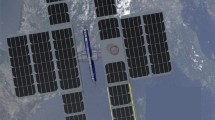Abstract
Due to the advancement of nano-satellite technology, CubeSats and fleets of CubeSats can form an alternative to high-cost large-size satellite missions with the advantage of extended spatial coverage. One of these initiatives is the Cubesats Applied for MEasuring and LOcalising Transients (CAMELOT) mission concept, aimed at detecting and localizing gamma-ray bursts with an efficiency and accuracy comparable to large gamma-ray space observatories. While precise attitude control is not necessary for such a mission, attitude determination is an important issue in the interpretation of scintillator detector data as well as optimizing downlink telemetry. The employment of star trackers is not always a viable option for such small satellites, hence another alternative is necessary. A new method is proposed in this series of papers, utilizing thermal imaging sensors to provide simultaneous measurement of the attitude of the Sun and the horizon by employing a homogeneous array of such detectors. The combination with Sun and horizon detection w.r.t. the spacecraft would allow the full 3-DoF recovery of its attitude. In this paper we determine the spherical projection function of the MLX90640 infrasensors planned to be used for this purpose. We apply a polynomial transformation with radial corrections to map the spatial coordinates to the sensor plane. With the determined projection function the location of an infrared point source can be determined with an accuracy of \(\sim 40^{\prime }\), well below the design goals of a nano-satellite designed for gamma-ray detection.









Similar content being viewed by others
Notes
References
Holland, J. H.: Adaptation in Natural and Artificial Systems. University of Michigan Press, Ann Arbor (1975)
Jahoda, K., et al.: HaloSat: Early results on the mass of the Milkyway halo. American Astronomical Society Meeting Abstracts 233, 462 (2019)
Melexis MLX90640 32x24 IR array datasheet (https://www.melexis.com/-/media/files/documents/datasheets/mlx90640-datasheet-melexis.pdf)
Mészáros, L., Jaskó, A., Pál, A., Csépány, G.: Accurate Telescope Mount Positioning with MEMS Accelerometers. PASP 126, 769 (2014)
Ohno, M., et al.: CAMELOT: design and performance verification of the detector concept and localization capability. Proceedings of the SPIE 10699 (1069964), 12 (2018)
Pál, A.: FITSH - a software package for image processing. MNRAS 421, 1825 (2012)
Pál, A., et al.: CAMELOT - Concept study and early results for onboard data processing and GPS-based timestamping, arXiv:1806.03685(2018)
Smith, M., et al.: On-orbit results and lessons learned from the ASTERIA space telescope mission (2018)
Werner, N., et al.: CAMELOT: Cubesats Applied for MEasuring and LOcalising Transients mission overview. Proceedings of the SPIE 10699(106992P), 15 (2018)
Acknowledgements
The authors would like to thank the support of the Hungarian Academy of Sciences via the grant KEP-7/2018, providing the financial background of our experiments. This research has been supported by the European Union, co-financed by the European Social Fund (Research and development activities at the Eötvös Loránd University’s Campus in Szombathely, EFOP-3.6.1-16-2016-00023). We also thank the support of the GINOP-2.3.2-15-2016-00033 project which is funded by the Hungarian National Research, Development and Innovation Fund together with the European Union.
Author information
Authors and Affiliations
Corresponding author
Additional information
Publisher’s note
Springer Nature remains neutral with regard to jurisdictional claims in published maps and institutional affiliations.
Rights and permissions
About this article
Cite this article
Kapás, K., Bozóki, T., Dálya, G. et al. Attitude determination for nano-satellites – I. Spherical projections for large field of view infrasensors. Exp Astron 51, 515–527 (2021). https://doi.org/10.1007/s10686-021-09730-y
Received:
Accepted:
Published:
Issue Date:
DOI: https://doi.org/10.1007/s10686-021-09730-y




